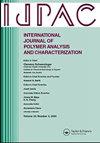Thermal stability, flame retardancy and mechanical properties of casein-based rigid polyurethane foam with starch and sepiolite as fillers
IF 1.6
4区 工程技术
Q4 POLYMER SCIENCE
International Journal of Polymer Analysis and Characterization
Pub Date : 2025-04-03
DOI:10.1080/1023666X.2024.2449526
引用次数: 0
Abstract
Casein-based rigid polyurethane foam (RPUF) with different ratios of starch and sepiolite were prepared by a one-step process. Thermogravimetric analysis, CONE analysis, scanning electron microscopy analysis, limiting oxygen index (LOI) analysis, vertical combustion analysis, and mechanical property analysis were used to explore the thermal stability, flame retardancy, and compressive properties of the modified RPUFs, respectively. The results showed that the initial decomposition temperature and activation energy (E) of RPUF-C5ST2SE3 (5 g casein, 2 g starch, and 3 g sepiolite) were the highest. Under the condition of radiant flux of 50 kW/m2, the peak heat release rate (PHRR), total heat release (THR), peak smoke production rate (PSPR), and total smoke release (TSR) were reduced by 35.92%, 10.83%, 36.67%, and 18.20%, respectively, compared with the RPUF without flame retardant. By analyzing the carbon residue, it was found that RPUF-C5ST2SE3 had the highest carbon residue and its carbon residue morphology was relatively intact. In addition, the RPUF-C5ST2SE3 had the highest LOI and a UL-94 rating of V-0. At the same time, it also had the best mechanical property. The present experimental results can provide a useful reference for future RPUF flame retardant studies.

以淀粉和海泡石为填料的酪蛋白基硬质聚氨酯泡沫的热稳定性、阻燃性和机械性能
采用一步法制备了淀粉与海泡石配比不同的酪蛋白基硬质聚氨酯泡沫(RPUF)。通过热重分析、CONE分析、扫描电镜分析、极限氧指数(LOI)分析、垂直燃烧分析和力学性能分析,分别考察了改性RPUFs的热稳定性、阻燃性和压缩性能。结果表明,RPUF-C5ST2SE3 (5 g酪蛋白、2 g淀粉、3 g海泡石)的初始分解温度和活化能(E)最高。在辐射通量为50 kW/m2的条件下,峰值放热率(PHRR)、总放热率(THR)、峰值产烟率(PSPR)和总放烟率(TSR)分别比未加阻燃剂的RPUF降低了35.92%、10.83%、36.67%和18.20%。通过对残炭的分析,发现RPUF-C5ST2SE3残炭含量最高,残炭形态相对完整。此外,RPUF-C5ST2SE3具有最高的LOI, UL-94评级为V-0。同时,它还具有最佳的力学性能。本实验结果可为今后RPUF阻燃剂的研究提供有益的参考。
本文章由计算机程序翻译,如有差异,请以英文原文为准。
求助全文
约1分钟内获得全文
求助全文
来源期刊
CiteScore
3.50
自引率
5.30%
发文量
37
审稿时长
1.6 months
期刊介绍:
The scope of the journal is to publish original contributions and reviews on studies, methodologies, instrumentation, and applications involving the analysis and characterization of polymers and polymeric-based materials, including synthetic polymers, blends, composites, fibers, coatings, supramolecular structures, polysaccharides, and biopolymers. The Journal will accept papers and review articles on the following topics and research areas involving fundamental and applied studies of polymer analysis and characterization:
Characterization and analysis of new and existing polymers and polymeric-based materials.
Design and evaluation of analytical instrumentation and physical testing equipment.
Determination of molecular weight, size, conformation, branching, cross-linking, chemical structure, and sequence distribution.
Using separation, spectroscopic, and scattering techniques.
Surface characterization of polymeric materials.
Measurement of solution and bulk properties and behavior of polymers.
Studies involving structure-property-processing relationships, and polymer aging.
Analysis of oligomeric materials.
Analysis of polymer additives and decomposition products.

 求助内容:
求助内容: 应助结果提醒方式:
应助结果提醒方式:


